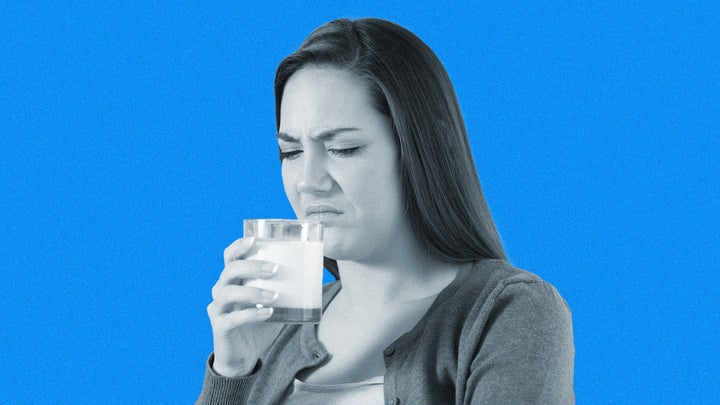
The sniff test is a method you’ve probably used hundreds of times to determine whether that carton of milk is still good enough to splash into your morning coffee, or whether you can eat that container of leftovers that’s been in the fridge awhile.
Recently, Morrisons began encouraging its shoppers to use the sniff test as a way to cut down on food waste. The chain announced in January that it was forgoing use-by dates on milk, instead using “best before” dates and urging consumers to use the sniff test to tell whether the milk is still drinkable.
It’s an effort to prevent hundreds of thousands of pints of milk from being unnecessarily thrown away each year because of an old use-by date – even though most milk products are still consumable for a few days after that point.
Kristen Gibson, associate professor of food science at the University of Arkansas System Division of Agriculture, acknowledges the importance of reducing food waste and that product date stamps can be puzzling. But she said encouraging the sniff test can be confusing for consumers.
“There’s a fine line between food safety and food quality,” she tells HuffPost. “There’s no way possible to sniff and tell if a food is safe. You could probably tell the quality has gone downhill. But to know that it is safe is impossible.”
So, what does the sniff test actually tell you about food? We asked food safety experts to explain.
The use-by, sell-by date confusion
Sell-by dates signal how long a store should stock a product. Use-by dates and “Best By/Before” describe when a food will be at its optimal flavour or quality.
“These dates don’t tell you anything about the safety,” said Martin Wiedmann, food safety and food science professor at Cornell University College of Agriculture and Life Sciences. “If your yoghurt says best before X date, that means it’s going to taste great and the way it should at least before that date. Afterward, the longer you wait, the higher the risk that it doesn’t taste quite as well. But that doesn’t make it less safe.”
Dates on products are derived from “shelf-life studies,” which Gibson said food brands conduct to analyse the quality of their products over time. “They’re analysing for spoilage, microorganisms or other properties, such as the appearance or other factors that are going downhill that would be unacceptable to the customer,” she explained.
Often, if stored properly, foods remain edible for a few days past the dates on the packaging, Wiedmann adds. And that’s where the sniff test comes in.
“The sniff test is a way to determine whether something is going to taste OK as sort of a quick screen,” he said.
What can the sniff test really tell you?
Natural changes caused by the growth of microorganisms and breakdown of proteins, carbs and fats over time cause foods to spoil, according to the Institute of Food Technologists. Spoilage creates changes in a food’s appearance, taste, smell and texture – and, that’s usually a quality issue.
Food quality isn’t the same as safety, though. If your milk smells sour, for example, you probably don’t want to drink it but it won’t necessarily give you foodborne illness.
“I wouldn’t eat it or drink it,” Gibson said. “I think the experience would not be very pleasant. But it shouldn’t cause you harm. You may get nauseous just because you ate something that wasn’t appealing, but it shouldn’t cause any sort of infection or something.”
Everyone also has their own standards for what’s acceptable quality, she explained. Some people might not mind a stale potato chip or slightly sour yogurt, while it might make others gag.
Someone’s expectation of what food should be plays a role, too, Wiedmann says. For instance, you wouldn’t want to mix curdled milk into your coffee.
“But the reality is that same process that puts the milk into little chunks can also be used to make cheese or make yogurt,” he says. “Many microbes grow and don’t make you sick; they just change the consistency.”
Why can’t the sniff test tell you whether a food is safe to eat?
The sniff test can’t identify whether a food is safe to eat. “You can’t taste organisms that cause disease in a food, and you can’t sniff it,” Wiedmann says.
Most foodborne pathogens, such as norovirus, salmonella or E. coli, can cause nausea, diarrhea or stomach cramps at small levels, “way beyond a level where you can smell it or detect it,” he explained.
A good example is lettuce, which is to blame for a large portion of foodborne illness and is the subject of many food safety recalls. Lettuce leaves might be green and crisp but could have bacteria lurking. “That organism is going to do nothing to impact the quality of the product because it is not designated to use the lettuce as a host – we’re the host,” Gibson added, explaining that once that lettuce is consumed, the bacteria would make a person sick.
There can be some crossover between food quality and safety, Gibson says. But foods can contain harmful pathogens, regardless of whether they taste or smell bad.
Fresh fruits and vegetables, refrigerated foods, poultry and deli meats have a higher risk for foodborne pathogens. If these foods smell or taste odd, Gibson says, the safest choice might be to avoid them.
But, she emphasised, “There’s no way to use the sniff test to tell the safety of a food product. It can be useful for telling if the quality has declined.”